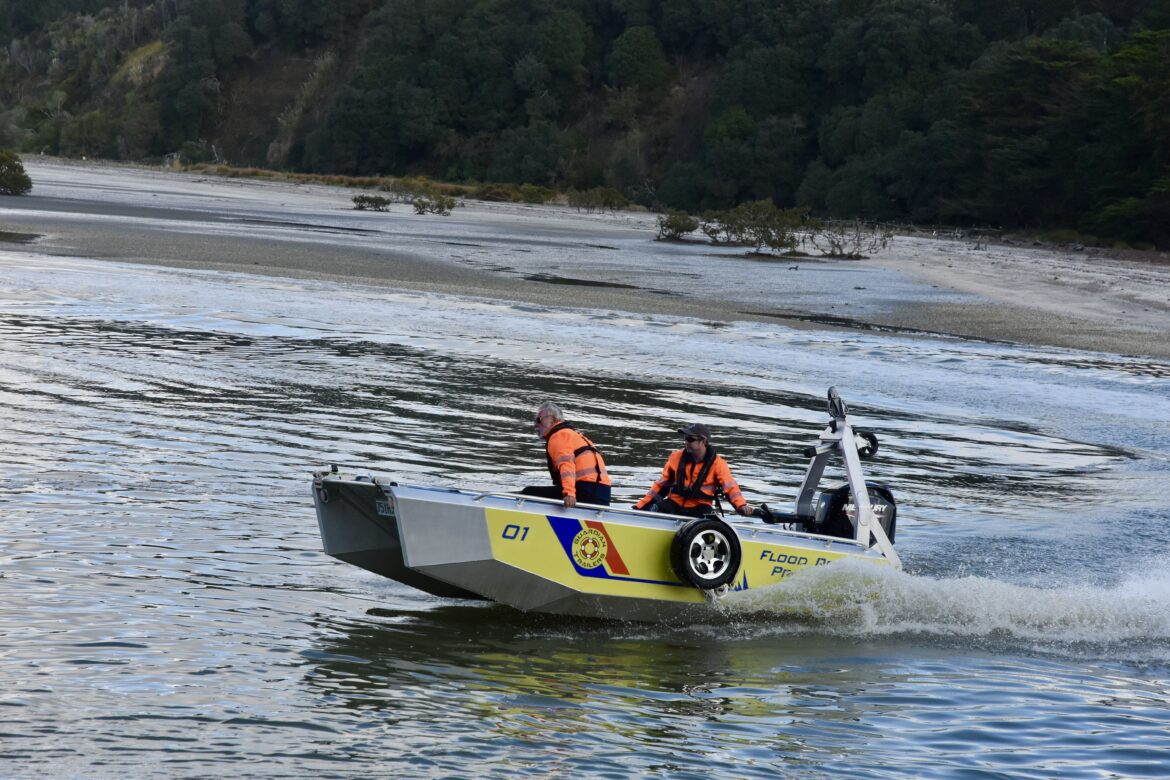AND NOW FOR SOMETHING COMPLETELY DIFFERENT…
The Flood Rescue Craft with global capability designed and built by an innovative Kiwi Boatbuilder.
While wandering around the Auckland Hutchwilco Boat Show earlier this year, as I passed the Dreadnort display, I glanced about to see if Blair Lewis (designer and owner of Dreadnort Boats) was around; wanting to ask him what was new since the boat test review we had done on his D4000 in late 2022 and on the V4000 in 2023. However, seeing him engaged with a customer, I strolled by, scanning the various craft on display. It wasn’t until I was about ten metres past the stand that I went, “Whoa, what was that?” Quickly circling back, I witnessed the most unusual craft I’ve seen in a long time – the Guardian Trailer Flood Rescue Prototype.
But it isn’t a trailer; well yes, it is, but it is also a boat (well more like a landing craft) with retractable wheels, which sort of makes it an amphibian vessel. But it has an outboard, but not with a propeller, but rather a jet pod and it tows from the stern with a tow bar that remains an integral part of the boat once launched. It also has a watertight drop-down ramp at the bow. Baffled? So was I! Noticing that Blair was now free I corralled him, asking “What is this thing?” And “Why is there such a thing on your stand and why is it called a Flood Rescue Prototype as well as being named a Guardian Trailer?” There were many more questions to come.
The more I spoke with Blair, the more intrigued and interested I became. Cutting a long story short, Blair told me that having watched the flooding in Australia over the past decade getting worse, it was only a matter of time until it knocked on our doorstep here in New Zealand as well. Prescient he turned out to be, as all of us here in New Zealand will recall the devastating floods across the country back in February 2023. So, a concept was born out of necessity following the frustrating response to those 2023 New Zealand floods, when Blair, watching the regular news feeds, witnessed firefighters and other first responders unable to rescue stranded people who had been cut off by the flood waters, even though often less than a few hundred metres away. The tools that rescue crews had were simply insufficient. In Blair’s mind, a rescue craft, similar, but quite different to a surf lifesaving RIB, was needed with the design requirements calling for a robust, safe, stable, simple to operate, affordable, road-legal amphibious vessel designed specifically for first responders for flood rescue. And that really says it all. Consequently, the Flood Rescue Prototype was born. It’s a bit of an ‘Ugly Duckling” but there is much more than meets the eye and everything about this vessel has been done for a reason.
Guardian Trailers (a collaboration between the naval architecture firm Transformarine and the shipwright firm Altech Marine, based in Auckland) set out to design and build a craft that could be used anywhere, anytime by anyone. Combining the boat and trailer into one leaves the tow vehicle unconstrained for other operations. More importantly, it does not have to be the same vehicle that retrieves it, leaving the Flood Rescue craft free to travel long distances on its own if necessary and then, when ready to be retrieved away from its original launch site, simply have any suitable vehicle with a tow bar, able to trailer it away. Thus, the biggest benefit of having the trailer built-in for emergency applications is to allow the launch vehicle to be unencumbered by a trailer.
Another key consideration was that it had to be easy to use and this vessel is designed around the KISS (Keep It Simple Stupid) principle – one of my favourite axioms when it comes to any sort of craft being used on oceans, lakes or rivers and especially relevant if it is going to be used in treacherous flood zones. Overly complicated vessels can become dangerous. With simplicity being the key, we’ll explore this aspect a bit more later.
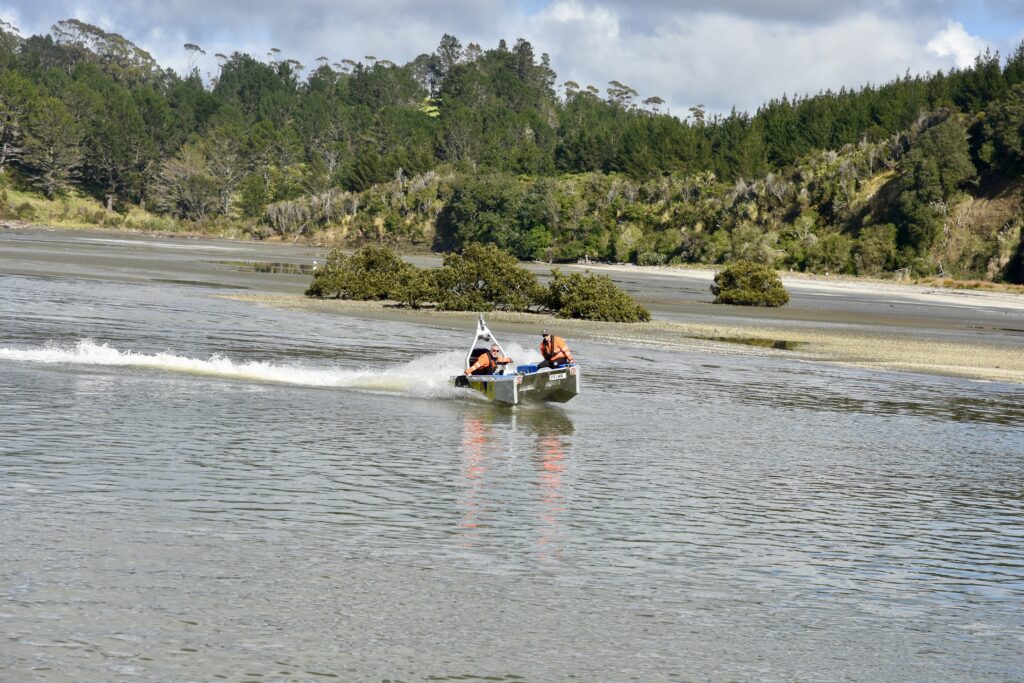
As alluded to above, if this duplicitous craft is to be quickly towed to an emergency site, the trailer part must be road-legal and able to be drawn by any vehicle capable of hauling an unbraked unit under 750kg. The Flood Rescue Craft is exactly that! Its wheel ‘lock down’ system, hidden under the skin, has been incorporated to take road loads off the electric actuators for added road safety. Considering the various water environments, in which it was to be used, the electrically articulated trailer wheel system has been fabricated from aluminium and stainless steel to reduce maintenance. And, like a Formula 1 car, the suspension is inboard; not to improve aerodynamics, but to keep the suspension out of hostile elements. When it came to the hull design, only a catamaran could provide the best possible stability for safety at rest as well as for high-speed performance, especially in shallow, debris-ridden waters. The resultant catamaran hull form, with an underwing central portion that rides partially in the water when planing in order to feed clean water to the jet, thus not only improving stability, but helping with tracking. This craft can be hurled through extremely tight turns under maximum speed without the aft end losing grip, preventing the craft from skittering all over the water’s surface.
As for the propulsion unit, only one option made sense: a jet pod outboard motor. After a lot of investigation, Blair settled on a 60hp (reduced to 40hp with the jet pod replacing the traditional propdriven lower outboard leg) Mercury Four Stroke. When rescuing someone from the water, the last thing you need is a fast-spinning propeller slicing into your would-be rescuee! The jet unit also importantly aids in shallow water running and is less likely to damage itself when navigating flotsam-laden flood waters. Should the jet unit be damaged, it is quick, easy and cost-effective to repair or replace. In summary, Blair endeavoured to get the best balance of size, weight and propulsion, figuring the ideal weight had to be less than 650kg and definitely less than 750kg to meet unbraked towing requirements.

Rescue is what this craft is all about, so a lot of consideration was focused on making the bow an easily accessible part of the design, whether motoring up to shore, lowering the bow door for easy access to aid distressed and/or injured people to being wide enough for a wheelchair, as well as being equipped with steps for deeper water access enabling a rescuee to climb into the boat with minimum difficulty, even if fatigued.
Solid aluminium construction was of immense importance, as this vessel was designed to be used in extreme environments. Imagine, if you will, a flooded, fast-flowing river or expansive flood plain strewn with debris, logs floating containers or even dead and bloated livestock – this craft had to withstand whatever a flood was going to throw at it and, if damaged had to be easily and quickly repairable. Five separate watertight compartments (soon to be increased to nine) have been built into the design, as segregation is key to the vessel staying afloat should one or more compartments be compromised. Enough background, this craft cried out to be tested in as ‘real-world’ conditions as possible. The potential of the Flood Rescue Vessel cannot be overlooked. Mentioning this to Doug, the publisher of this magazine, he immediately asked me, “How soon can we do a boat test, and you write an article?” After a bit of discussion, it was agreed that we needed to trial this craft in simulated flood conditions to really get a sense of what it is capable of doing. Hmm, Auckland in July? We shouldn’t have to wait long. Too true – Sunday, July 14th and the forecast for the following day was for strong winds and lots of rain. We therefore arranged to meet at the Weiti River Wharf (previously reconnoitred as a suitable test site) on Monday morning to do the test. Well, that got washed away (pun intended) as Monday turned out to be so horrible, that any thoughts of getting good photos and drone footage were abandoned and we elected to wait a day, figuring the leftovers from the storm would still provide a creditable flood-like environment. Thus, it turned out to be with a foggy morning, little wind and the Weiti River dirty brown and flooded. Perfect!
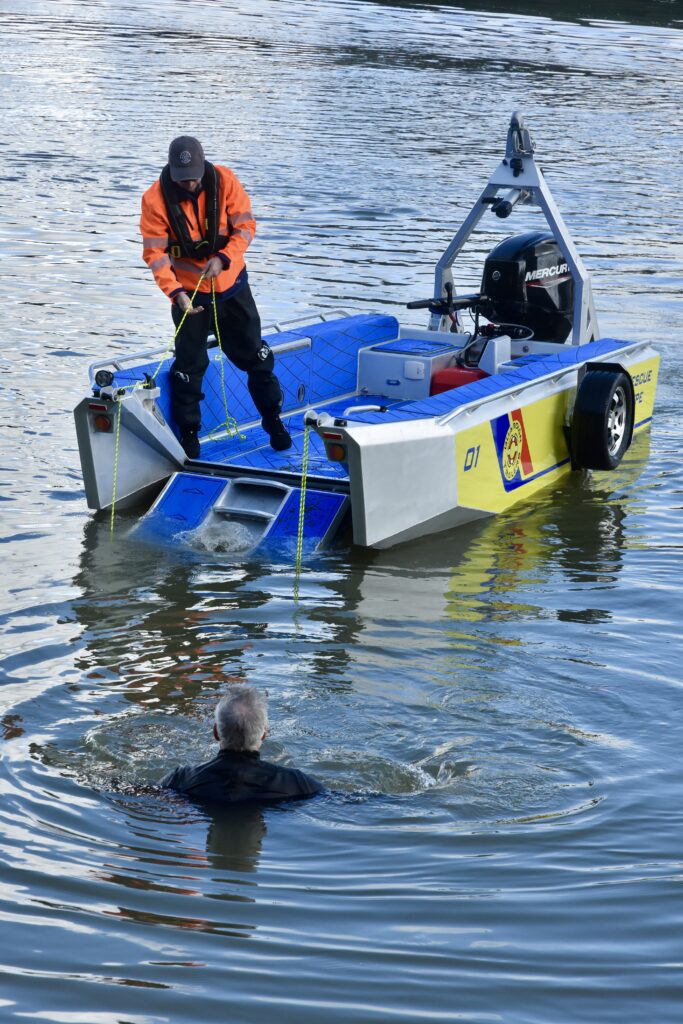
This was to be a boat test like no other I had previously done, as we wanted to simulate (as close to reality as possible) a ‘flood rescue’ scenario. But in addition to finding out whether or not this craft met the criteria Blair originally had in mind when he set out to design and build it, we also wanted to photographically and video document the test so that Blair could graphically illustrate to emergency response organisations how this craft could positively impact flood rescue emergencies.
The ten key criteria for this boat review were established beforehand as follows:
- How straightforward is it to get the craft to the emergency site? This vessel can be hooked up to almost any vehicle with a tow bar that is capable of pulling a maximum of 750kg. Hook up the Guardian Trailer and head for the rescue site.
- How quickly and easily can it be launched and retrieved? Launching the vessel is just as easy as launching any small trailer boat, and once in the water, the tow vehicle doesn’t have to hang around, as the craft can be retrieved without difficulty from a different location with an alternative ‘tow capable’ vehicle and it is capable of being launched and retrieved by one person.
- How manoeuvrable is it in deep and shallow water? The hull design, coupled with the outboard motor jet propulsion unit, enables this unique vessel to get up on the plane fast whether in deep or shallow water and can navigate debris-strewn flood waters with relative impunity.
- How effective and feasible are shallow shoreline flood rescues? Extremely straightforward! With its shallow draft and water jet propulsion, it behaves just like a classic landing craft (albeit a fast one). Ease up to the shoreline, drop the forward mechanically activated, pully system stepped ramp and the rescue victim can simply clamber aboard, even if quite likely, exhausted and/or injured.
- How effortlessly can people, floundering in deeper water, be rescued? Easier than from any other craft I’ve ever come across. Get to the victim’s location fast, idle up to him/her, drop the forward-stepped ramp and help him/her scramble aboard. Pull up the ramp and quickly head for safety.
- How stable and safe is it? This vessel personifies stability! With its catamaran hull design, abundant buoyancy chambers and a relatively wide beam-to-length ratio, this thing sits on the water at rest as though it was glued to the surface.
- How capable is it? I can think of no other vessel (including a RIB) that could be more adept at achieving what it was designed to do. The name on the hull says it all: Flood Rescue.
- How robust and maintenance-free is it? The hull is built with 4 mm aluminium and will incorporate nine separate watertight flotation compartments. All of the interior and topsides are lined with soft but resilient U-dek deck tread throughout. Vessel instrumentation and controls (as well as road-legal sealed LED trailer lights – hooked up by a standard trailer waterproof plug) are kept simple and the whole craft can be washed out and cleaned rapidly with little effort. The wheel system is constructed from aluminium and 316 S/S further reducing maintenance. No jack is required to change a flat tyre.
- How can it be used for other applications? Besides its primary functions of flood rescue and SAR, the nature of this vessel lends itself to other utilitarian as well as recreational uses. The best example of the former, being its capability to be modified for loading quad or trail bikes for water transport to remote (or flooded) areas of farmland or other possibilities, such as livestock rescue, conservation and general maintenance work. In addition, what a great fishing, dive or family adventure boat, to name but a few recreational uses.
- Finally, does it meet the “KISS” criteria? Absolutely! Considering what this craft was designed to do, only if I were being extremely critical, could I find anything that might not comply with the “KISS” principle. Having said that, take another look at the images and you will note that the lettering on the craft says: Flood Rescue Prototype. Emphasis here on ‘Prototype’. In discussions with Blair during and after our day out, he was abuzz with ideas for improvements and I am extremely confident that once production units are rolling (literally) out of the factory, they will be totally fit for purpose
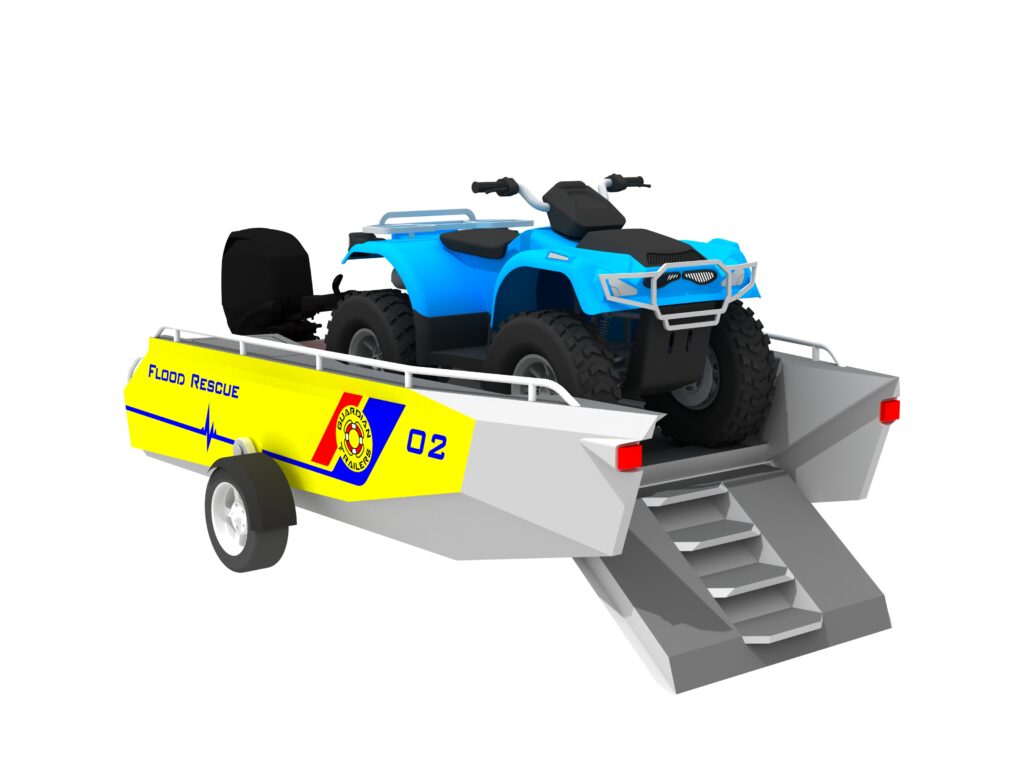
SUMMARY
As will be seen from the images throughout this article, it was an adventurous day out, during which I feel, we succeeded in our flood rescue simulations. Whether I or Blair was at the helm, the craft performed as advertised every step of the way. From launch to on-water manoeuvres at low and high speeds, both in shallow and deeper water and while executing simulated rescues, to final retrieval at the boat ramp, this craft lived up to its promise.
A few days after the test I phoned Blair to discuss a few things about the craft and also asked if he had been looking abroad for other possible markets. “Definitely”, came back his reply and “Look Ron, you may want to check out the link I’ll send you” (refer following): www.marinebusinessnews.com.au/2024/07/marine-rescuensw-tests-flood-rescue-and-support-capability/
Well, as it turns out, our Aussie cousins have been playing around with their own ideas for Flood Rescue craft, but having seen what Blair has come up with, it appears that they may have realised that the Guardian Trailer, although similar, could be a better option than what they have been developing. Unfortunately, back here in Godzone, Blair has been struggling to get the attention and interest of SAR, Coastguard and New Zealand Government Emergency Response organisations. I have been involved in the marine industry most of my life and rarely have I encountered a craft that has the potential to be a real game changer and a significant tool to help save lives when it comes to flood rescue. I only hope that this article may help get this valuable apparatus to front line first responders for use in their rescue operations. Once again, Kiwi innovation at the forefront!
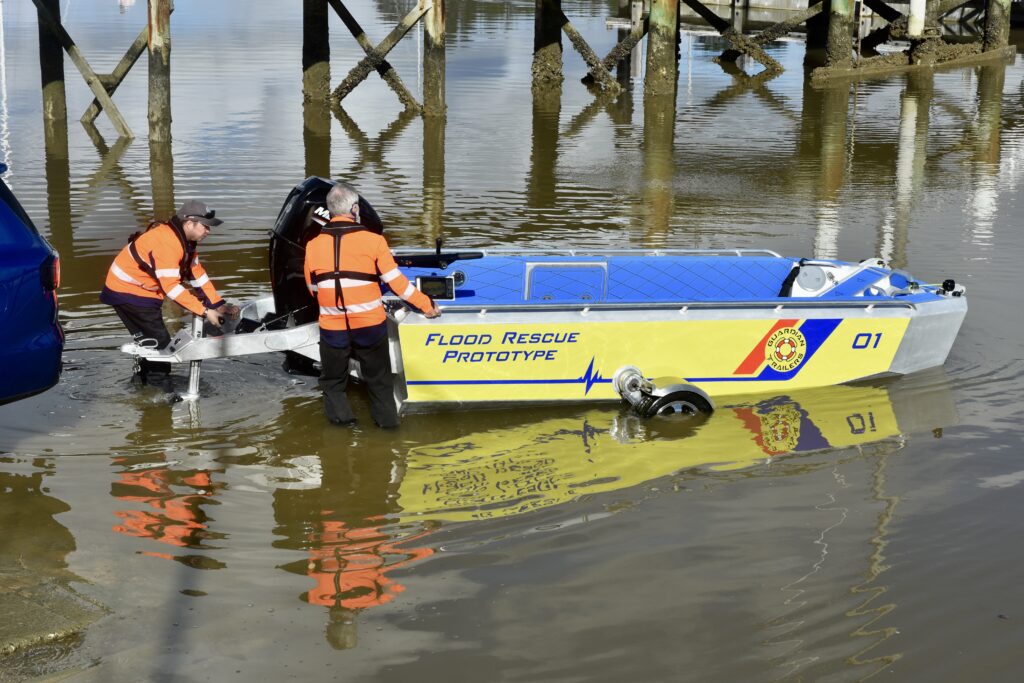
SPECIFICATIONS
Length 4.20m
Beam (hull) 1.90m
Overall Width 2.46m
Draft 0.30M
Displacement 1170kg
Weight (Dry) 650kg
Hull and Deck Thickness Both 4mm
PAX 7 Persons
Trailing Length 5.73m
Trailing Load Capacity 100kg
Maximum Speed 23 knots with 40hp Jet Outboard


